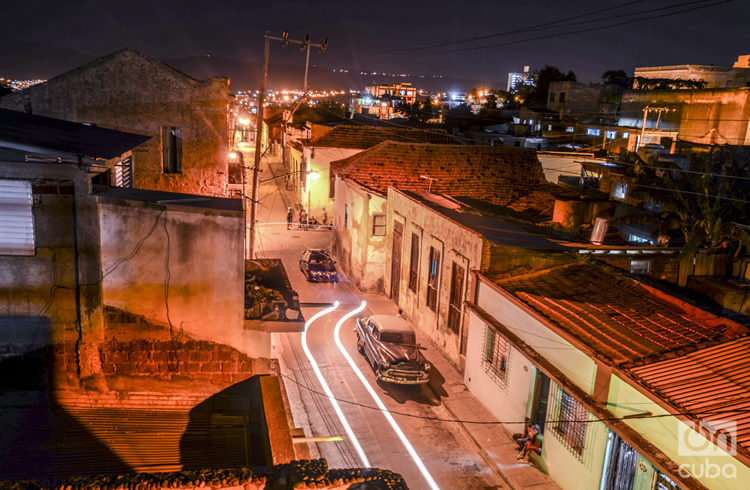As almost always happens in Cuba when it’s a question of planes and airports, this time I was able to get to Santiago through a combination of magic, stubbornness and resistance. A dark and hot Rancho Boyeros airport terminal 1 received me, surrounded by the dust of the construction. And all this without a notification to apologize to the passengers for the inconveniences they were causing. It seems these omissions are part of our service culture.
Whoever wants to go to fly to Santiago after being able to buy a ticket sufficiently in advance, has to, above all else, overcome this obstacle which is to dispatch your luggage in those conditions and later make time in a last waiting! room with the windows blocked off.
The landing was different. Santiago’s airport was modest but operative. However, I was surprised to see that information about the city, its most important sites, its most popular places, barely existed.
There was no sign telling national and foreign tourists we had arrived to such a special place, to a city so full of history.
I didn’t see a billboard that told visitors they had arrived at the place where Cuba’s rum had been born; that the Don Pancho blending factory is there, storing the unrepeatable. Nothing announces that one is in the city that gave birth to the son and cradled the Matamoros Trio.
At least I didn’t see those signs, when I entered the luggage room or when I left through its door, or when I traveled through the highways to the city. Those signs and billboards are also missing in the cruise port and in that won-over space that today is the seaside drive where Santiago residents enjoy the breeze and the WiFi connection.
Neither do those signs advertising Santiago de Cuba exist in other airports in the country, nor in other tourist destinations; sometimes tourists find out by chance that Santiago exists, at times because some tourist agency comes up with the idea of making a one-day tour of Santiago, from some beach in another territory.
Santiago must constantly try to counteract the geographic fatalism and which is present combined with that other evil that is killing us, the sectorial fatalism, which limits the territorial initiative.
And it’s a shame, because there’s a lot to see in Santiago de Cuba, even after and despite Hurricane Sandy which devastated the city in October 2012.
Santiago is one of the few cities in Cuba that is ideal for “city tourism.” The local authorities should have their own programs to attract their own national and international allies, and in that way they won’t have to depend only on a Ministry that is in charge of tourism for the State. No one better to think of Santiago than its inhabitants and its authorities.
The material shortages turn the 900 kilometers that separate Santiago from Havana into 9,000 if we get on the road adventure and into 90,000 if the adventure becomes an intergalactic trip on train. Santiago, like other cities in the country depends on Havana for its aircraft, for its trains, for its trade, for almost everything, since it depends on the sectorial ministries and their agencies also chiefly based in Havana.
The Ron Santiago is marketed from an office in Havana, and the mangoes from Caney (are there better ones?) were traveling to Consolación del Sur to then be marketed under a brand that has nothing to do with Santiago de Cuba.
Tourists arriving in Santiago, when they arrive, also depend on offices that are not close to the Plaza de Marte. Why isn’t there a tourism company devoted to selling the Santiago de Cuba product? Why is it so difficult for local governments to have their own offices to promote themselves as a tourist destination? Why can’t Santiago and its authorities negotiate their tourism and their products, including their delicious mangoes, with foreign agencies and companies? Why does everything have to be so sectorial? Who designs, promotes and sells the Santiago de Cuba destination? How many road shows about the Santiago de Cuba destination are organized by its authorities? Perhaps it is done, let’s hope they organize many.
Santiago is the Caribbean’s Cuban city par excellence, of that Caribbean through which some 27 million tourists travel every year. Santiago has its Caribbean Festival and its Fire Fest, but it has scarce economic relations with the Caribbean. Santiago faces the Caribbean in economic terms through a window in Havana; from one or several windows that are more than 900 kilometers away from the Bay of Santiago de Cuba.
And how is Santiago de Cuba inserted in the Caribbean’s economy?
That already famous 1 percent tax which the local authorities today can manage (within certain restrictions which should be a minimum) has helped them achieve what today they have in Santiago. What a shame that it’s only 1 percent! Why can’t it be more?
And then that poem dedicated to Santiago de Cuba written by Federico García Lorca would appear, verse by verse, on the city’s billboards: “When there’s a full moon I’ll go to Santiago.”
Don’t get me wrong, Cuba is one but at the same time it is many Cubas. And each one makes Cuba great based on its own identity, its people, its history. That’s why the territories have to have their own voice.










